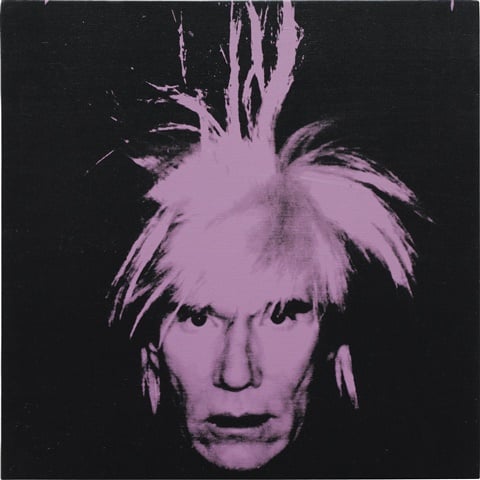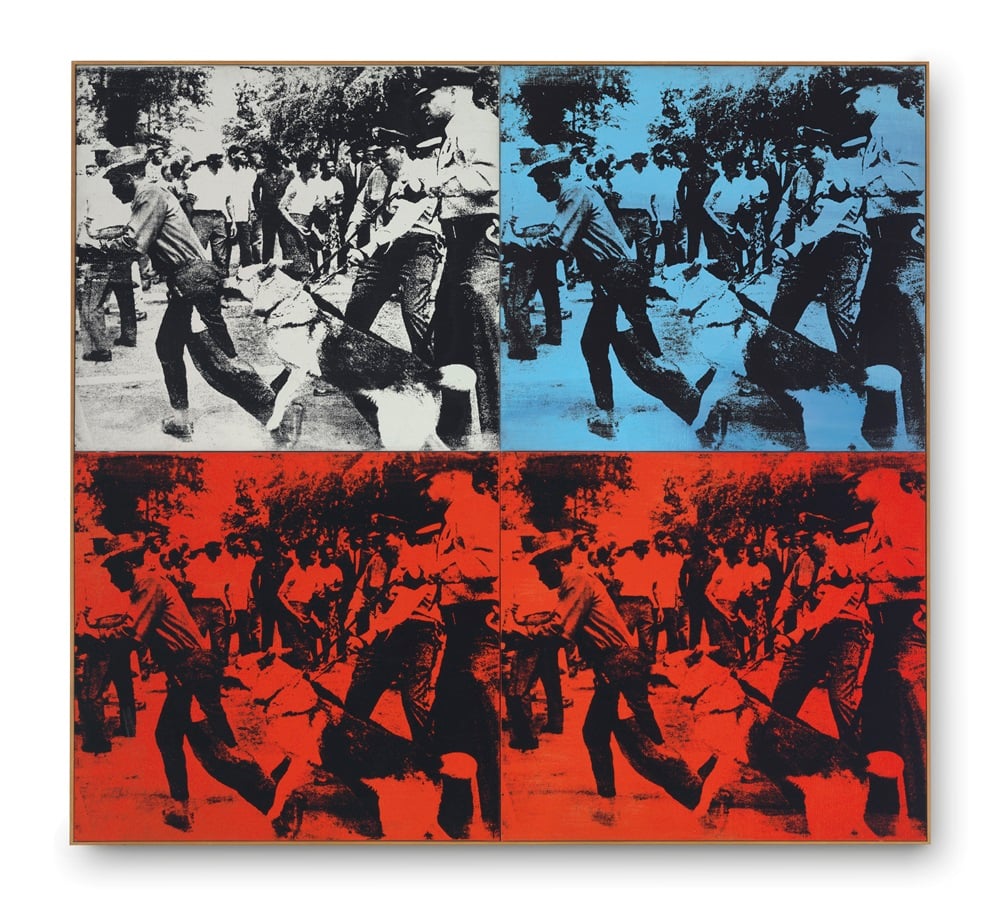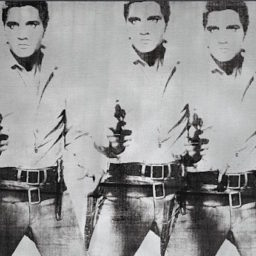


Andy Warhol, Self-Portrait (Fright Wig) (1986).
Photo: Courtesy of Phillips.
When Andy Warhol’s Self-Portrait (Fright Wig) (1986), an 80″ x 80″ canvas in pink, was picked up at Art Basel this year at the booth of New York-and-London-based Skarstedt Gallery for around $34 million, it took the top spot as the most expensive work reported to have sold at the fair. Although Warhol has always demonstrated universal appeal and enjoyed a strong market—and many in the industry would advise you to hang on to the masterworks—it seems like it’s a better time than ever for those who are inclined to sell. Which is to say, it’s a good time to sell for those collectors who happen to have an iconic Warhol lying around.
The upcoming contemporary art evening sales in London confirm this.
Nine Multicolored Marilyns (Reversal Series), a black canvas printed with nine ghostly negative images of Marilyn Monroe in a mix of blue, red, and pink, is one of the leading lots at Sotheby’s on June 30 and is on offer for £4–6 million (roughly $7–10 million).
If you want a crack at one of the Fright Wig self-portraits, you’ll have two shots. Christie’s is offering one 40″ × 40″ version in red and yellow on July 1, which is estimated to sell for £6–9 million (roughly $10–15 million), while Phillips is offering a 22″ × 22″ iteration in purple, which will be in the contemporary art evening sale on July 2 and is estimated to bring in between £2.5–3.5 million (roughly $4–6 million).
Warhol’s market, at least for trophy pictures, has been on a roll recently. In 2010, fashion designer Tom Ford sold his mammoth 9-foot Fright Wig, in purple, at Sotheby’s for $32.6 million (soaring past its $15 million high estimate). This past November Warhol’s Silver Car Crash (Double Disaster) (1963) sold for $104.5 million breaking the artist’s record at auction (and far outpacing its $60–$80 million estimate). Just last month, there was fierce bidding at Christie’s for his Race Riot (1964), which ended when art dealer Larry Gagosian scooped it up for $62.9 million. Likewise, the top lot at Sotheby’s in May was Warhol’s Six Self Portraits (1986), a suite of 22″ Fright Wigs in an array of candy colors; it sold within its estimate for $30 million.
And then came Basel. With the Skarstedt sale at Basel, things became much more interesting.
New York–based Edward Tyler Nahem Fine Art was also offering an iconic Warhol. The artist’s 20 Pink Maos (1979) came with a sticker price of $8 million and three buyers were interested, according to the gallerist. The work, he says, is currently under consideration.

Andy Warhol, Race Riot (1964). Sold for $62,885,000 at Christie’s in May.
Photo: Courtesy of Christie’s.
“The demand for good Warhols has always been strong,” said Edward Tyler Nahem. “The painting I have, for example, I have been trying to get for six years.” While it may be a good time to buy, for those who can buy, Nahem said, “If you’ve got a work that fits the category of being iconic, it is indeed a good time to be selling.”
Art dealer Per Skarstedt, who sold the pink Fright Wig at Basel, was so confident in his ability to part with his Warhol, that he reportedly gave the winning buyer 15 minutes to decide. “This is the closest you come to an auction house as a dealer,” he told Bloomberg.
August Uribe, worldwide co-head of contemporary art at Phillips, has noticed the uptick in interest in works by Warhol over the past few years. He says that despite the fact that, in general, there are more works by Warhol on the market these days, there’s a selective market of buyers “chasing trophy images by the artist,” including “the self-portraits, the Marilyns, the Jackies, the flower pictures.”
Warhol’s Global Trend
There are also many new collectors in the game. When the Tom Ford’s Fright Wig sold at Sotheby’s in 2010, then-head of contemporary art at the auction house Tobias Meyer noted that there were many new collectors on the market that night. He told the New York Times, “Buying was totally global.”
The global trend has continued. At the Christie’s sale in May, 30 percent of the buyers were new and half of the top 10 lots were sold to Xin Li, deputy chairman of Christie’s Asia, who was bidding on behalf of telephone buyers. Also, further evincing the health of the market, that sale was the highest grossing single sale in Christie’s history.
![Andy Warhol, Triple Elvis [Ferus Type] (1963) sold for $81.9 million (estimate in the region of $70 million).Courtesy of Christie's.](https://news.artnet.com/app/news-upload/2014/11/009-Andy-Warhol-Triple-Elvis.jpg)
Andy Warhol,Triple Elvis [Ferus Type] (1963). Sold for $81.9 million (estimate in the region of $70 million).
Courtesy of Christie’s.
“They love him in Asia,” Uribe said. “Not only China, but Singapore, Indonesia. Go to a decent collector’s home anywhere in the world, and you won’t be surprised to see a Warhol.” He added, “In countries where the collectors are still on a learning curve—in comparison to their Western counterparts—and collectors are looking to art as an investment, Warhol provides a more stable choice to park their investments.”
In addition to seeking out financially sound choices, new collectors on the market are also looking to soak in some of the cultural cache of tried and true American artists.
Art adviser Alex Glauber notes that, much like Frick, Morgan, Vanderbilt, all of them great US industrialists of the early 20th century who collected European Old Masters and spent newly earned money on established cultural currency, today’s collectors from abroad are looking to the US for our established currency.
“New money from the US went to Europe, and European cultural history went to the US,” Glauber said of the industrialists. “Now, new collectors from Asia, the Middle East, et cetera, are sending their new money to us in exchange for our cultural history. And, if you’re looking for 20th-century American icons, nothing says that better than Warhol.”






